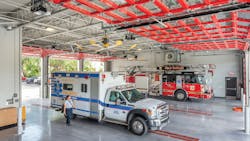A designated room to clean turnout gear off apparatus bays is nothing new. In 2010 we visited the Alexandria, Va., Fire Department’s newest station at Potomac Yard and I saw a separate room off the apparatus bay specifically for cleaning turnout gear.
I also saw a set of standard washers and dryers that, according to Alexandria’s Battalion Chief John North, were to be used to launder all station wear. Firefighters no longer were allowed to take their station wear home to wash. Nine years ago, Chief Mark Ober with the Anderson Township (Ohio) Fire and Rescue Department said his department was looking at new methods of decontaminating apparatus. He described a third-party, free-standing garage-type facility into which vehicles can pulled for decontamination.
Similarly, a study in 2008 by Arizona University found H1N1, MRSA, and other nasty bacteria on lounges and rugs in living areas of fire stations. Removal of carpeting, new antibacterial fabrics on furniture and the restriction of turnout gear to apparatus bays in stations has helped keep living areas safer.
The concept of Hot Zone design, separating contaminated areas from transitional and living areas, was first introduced in 2015 at the Station Design Conference in Baltimore and has made a huge difference in new fire station designs.
So awareness of health and contaminants in apparatus bays is almost ten years old.
Yet Bill Foster with Spartan Motors recently told me, “The fire service still has a long way to go when it comes to cleaning and decontaminating cabs.” He related a discussion with one fire department that stated it was “on top of cleaning the cabs after a fire... We take the air hose and just blow out the inside of the cab.” Foster said, “That’s simply blowing the contaminants around the apparatus bay.”
The current focus on cleaning cabs, isolating turnout gear and staging decon areas to keep first responders safe from carcinogens and other toxins is great news. But what about the emergency vehicle technicians (EVTs) that work on these emergency vehicles? It’s just as important to keep EVTs safe.
Years ago, there was concern about EVTs’ exposure to blood borne pathogens and MRSA in the backs of ambulances. It is now time to include EVTs with firefighters when we look for ways to reduce their exposure to carcinogens and toxins.
There are EVTs currently battling cancer, including a former EVT of the Year. In Wisconsin, one EVT developed prostate cancer and another was diagnosed with a very rare form of non-Hodgkin's lymphoma. Other EVTs struggle with COPD and lung complications. Whether EVTs work on fire apparatus in the station’s apparatus bay, public works shops or as independents, awareness in the importance of cleaning vehicles and a safe place to work is critical for first responders and the EVTs that work on their vehicles.
During the 2019 Station Design Conference in May, Robert Manns, Principal Architect, Manns Woodward Studios, presented “The Modern Apparatus Bay.” He covered how apparatus bays have evolved over the years and what factors drive their costs. Manns also reviewed other details about apparatus bays including lighting, mechanical systems, vehicle exhaust systems, fire protection and door operations.
“EVTs’ spend considerably more time in the bays than their counterparts, which only further highlights the necessity to ensure the apparatus bays are designed to give equal priority to response times as well as the health and wellness of occupants,” explained Manns. “In today’s world, addressing vehicle exhaust should be a given for any department. However, for EVT’s addressing physical health concerns, don’t start and stop there. Considerations need to be given to other features such as lighting and equipment locations. Carefully coordinated design solutions can reduce strain, improve work efficiency, and promote better ergonomics for the personnel responsible for keeping the apparatus at the ready.”
More and more departments are putting two air quality systems in their apparatus bays, as well as a smaller system in the turnout gear rooms (and also include a door to the apparatus bay).
“Having duel systems in place will definitely add additional protection,” said Tom Vitko, regional sales manager, Air Vacuum Corporation. "Prolonged, uncontrolled exposure to gasoline or diesel engine exhaust is a health hazard that's putting EVTs at risk every day. Automatically and continuously monitoring the air within the work place is critical to protecting your emergency personnel against these invisible contaminants.”
Vitko added, “The AIRVAC 911 System is designed to be an independent system that will address the complete Hot Zone apparatus area and 100% automatically remove both harmful gasses and particulates that onboard systems or hose systems only address part of the time (i.e. backwash that enters the building as vehicles pull out or when backing in).”
Relating EVT health issues to their vocation has proven a challenging endeavor, according to Al Hasenfratz, the 2019 EVT of the Year and Sylvania Fire-EMS, Master EVT Technician. He has decided to start tracking EVTs that are diagnosed with possible work-related illnesses and will focus on departments and facilities who service apparatus and ambulance only, including some independent repairmen as well.
“A few of the difficulties have been combined fleet repair shops and make it hard to connect fire mechanic illness to apparatus exposure exclusively,” Hasenfratz said. “Also it seems, most shops, employers, and even the techs themselves are hesitant or prohibited from discussing health issues.”
"EVT's are exposed to the same hazards known to kill firefighters, said Hasenfratz and advises, “Protect yourself. Disposable gloves and masks are cheap. Do whatever it takes!"
Due to the popularity of Rob Manns’ program on apparatus bays, he will present more on the topic at the 2020 Station Design Conference May 11-14, in Rosemont, IL.






